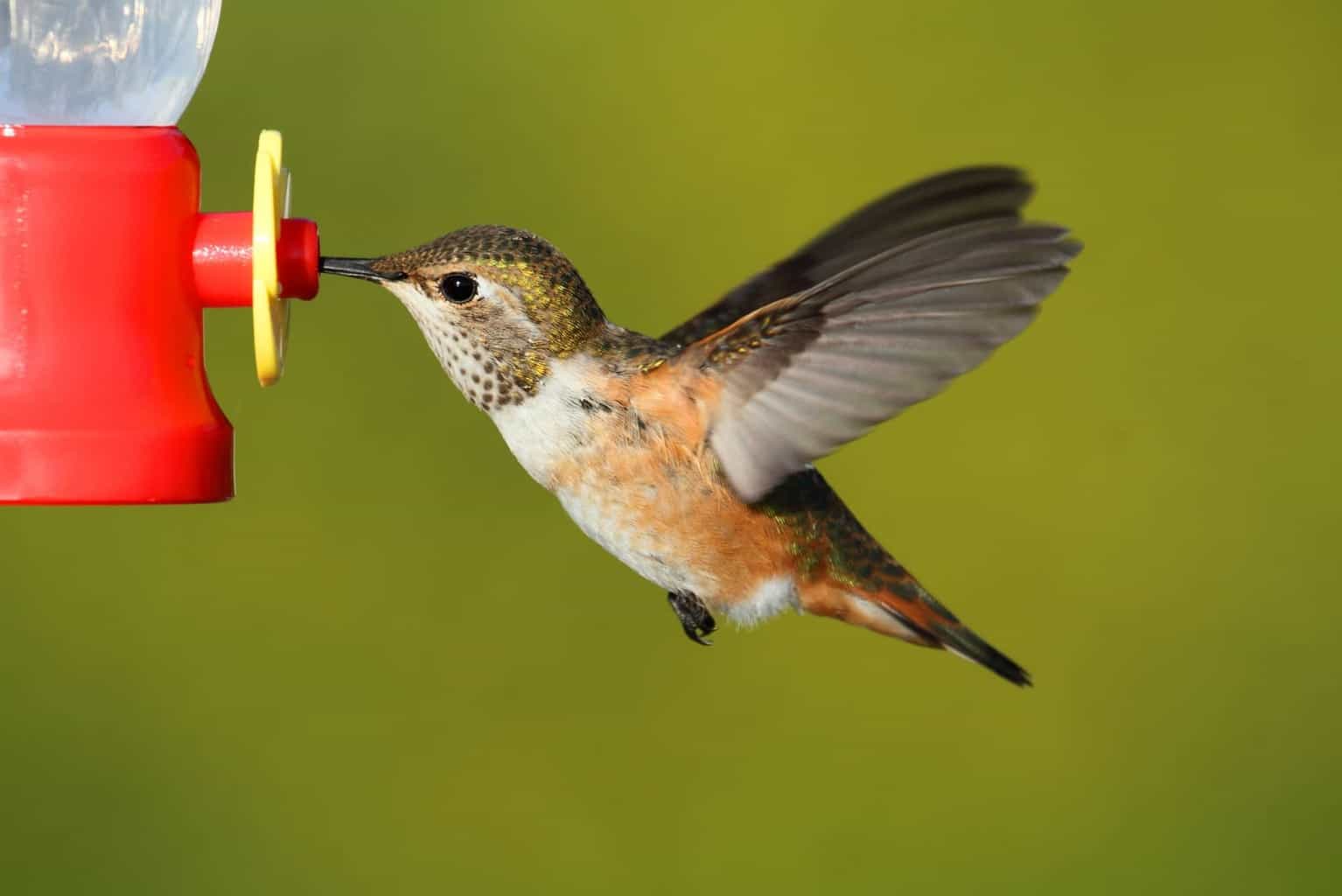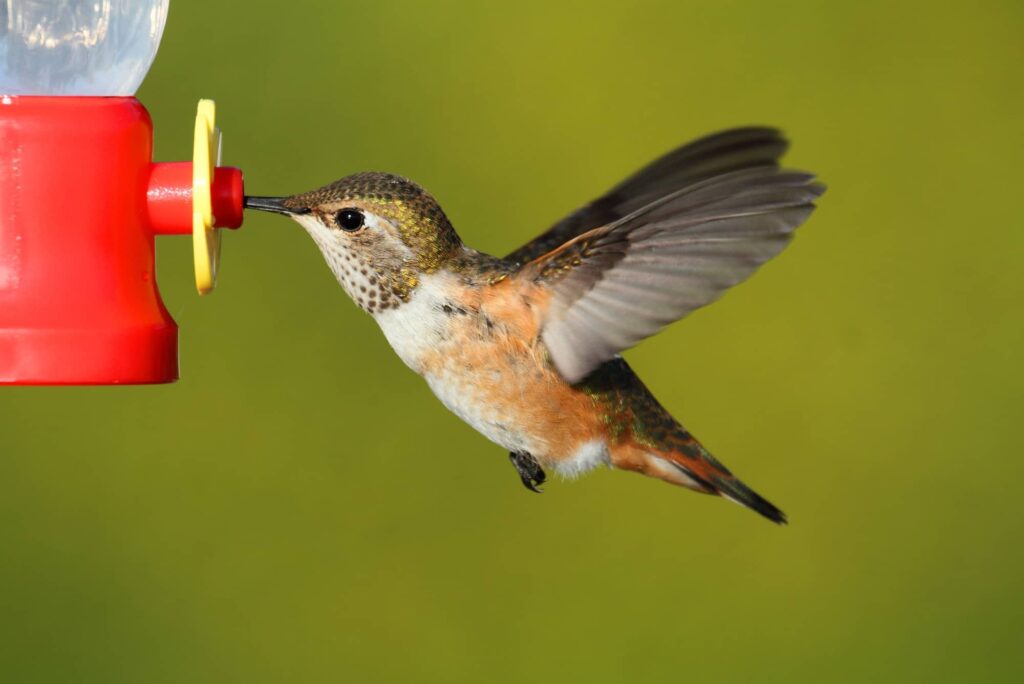Everything about hummingbirds brings a sense of awe. They’re incredibly tiny, weighing the same as a couple of paper clips! They’re the only birds that can fly backward and upside down, beating their wings an average of 53 times per second! Their rainbow-hued and iridescent feathers make them look like miniature, otherworldly works of art.
One thing’s for sure–seeing hummingbirds never gets old!
The hummingbird migration is a thrilling opportunity to see these beautiful little birds in action. If you put out some feeders, you can even get up close and personal with them. So when will the guests of honor arrive?
When Will Hummingbirds Arrive in Kentucky?
The species of hummingbird that migrates to Kentucky to breed are the charming and well-loved Ruby-throated hummingbirds. The males will come north sooner than the females, beginning their trek from Costa Rica, Panama, and Mexico and flying up into the eastern United States and Canada.
Ruby-throated Hummingbirds typically arrive in Kentucky in mid-April. However, they have been recorded arriving as early as the second half of March in some years.
When Should I Put Out Hummingbird Feeders in Kentucky?
Start putting out your hummingbird feeders about 1-2 weeks before you expect the hummingbirds to arrive. In Kentucky, you should put your feeders out in mid-March. Another way to figure out when to place your feeders is to watch for early Spring flowers to begin blooming. The early-arriving male hummingbirds are looking for these flowers, so you can take your cue from nature and start providing nectar feeders at this time.
What Kinds of Hummingbirds Come to Kentucky?
The Ruby-throated hummingbird is the only hummingbird species that breed in Kentucky. These are the hummingbirds that will typically come to your feeders, although you’re unlikely to see their nests. They prefer to nest in secluded areas.
During the return migration south for the winter, you might sometimes see stragglers of other species that do not typically range into Kentucky. Some species you might occasionally see include the Black-chinned hummingbird, the Rufous hummingbird, and, more rarely, the Mexican Violetear.
What is the Best Kind of Nectar for Hummingbirds?
To make nectar for hummingbirds, simply mix ¼ cup of sugar with 1 cup of water. It’s not necessary to boil it as long as you use the mixture immediately. Don’t add red dye to the nectar. It’s not good for the hummingbirds, and it’s not needed to bring them to your feeder.
Use a red hummingbird feeder with red bee guards, not yellow. Using red will attract hummingbirds, which are drawn to red, and avoid insects who cannot see the color red.
Do not use honey as a nectar ingredient. Fungus and mold can grow in honey, which is dangerous for hummingbirds.
It’s essential to keep your feeders freshly stocked and well-cleaned throughout the hummingbird season. Thoroughly clean feeders every day when the weather is hot and every other day at most.

Where Should I Place My Hummingbird Feeders?
If you have red flowers or flowers that produce nectar, place your feeders nearby to help the hummingbirds find them. You can also place your hummingbird feeders either very close to a window for viewing or at least five feet away. These two positions protect the hummingbirds from window strikes.
If you have more than one hummingbird feeder, you should position them at least 15 feet apart, and ensure that they are not visible to one another. Hummingbirds are highly territorial. One male hummingbird will keep all other males away from “his” feeder!
Don’t place your feeder in direct sunlight; the nectar solution will go bad faster. But don’t put them in dense shade either; it will be harder for the hummingbirds to spot the feeders that way.
When Should I Take Hummingbird Feeders Down in Kentucky?
You can take down your hummingbird feeders two weeks after you see the last hummingbird use them, or in mid-December. This ensures that migrating hummingbirds will get all the nectar they need to fuel their journey south.
You don’t have to worry that leaving the feeders out will prevent hummingbirds from migrating when they need to. Sometimes hummingbirds may linger at feeders to feed enough before they fly onward. At other times, you may see stragglers taking a later journey, or a more unusual route. Either way, they’ll migrate when the days get shorter.
Do Hummingbirds Return to the Same Place Every Year?
Hummingbirds have an extraordinary memory and will return to the same feeders repeatedly. One feeder provides anywhere from 2,000 to 5,000 times as much nectar as a flower, so it’s a food source worth remembering!
However, if the hummingbirds return and the feeders are not out, they will be forced to look elsewhere for food. They must feed sometimes as often as every five minutes to keep up their amazing flight speed.
Which Kentucky Flowers Attract Hummingbirds?
A garden with a diversity of flowers and some small trees and shrubs for cover and rest is a great way to attract hummingbirds. Hummingbirds especially love Cardinal Flowers (Lobelia cardinalis), which are native to Kentucky. Another Kentucky native that is easy to grow is Jewelweed (Impatiens capensis). They are annuals that grow two kinds of flowers and are a favorite of hummingbirds.
Kentucky native vines like trumpet honeysuckle, passionflower, and trumpet creeper are sure-fire hummingbird favorites. Bee Balm (Monarda didyma) is an interesting-looking, spiky flower that hummingbirds love. It will seed itself in your garden and you can divide it every three to four years.
Zinnias (Zinnia spp.) are popular and easy-to-grow flowers that are very hummingbird friendly. There are hundreds of varieties to choose from, so you can put your favorites in your garden. Insects are an essential part of a hummingbird’s diet. You can attract them by growing Purple Coneflowers (Echinacea purpurea).
A Special Secret to Attracting Hummingbirds
As an extra hint: hummingbirds love spiders! They will eat insects directly from spiders’ webs and the spiders themselves. They also use spiderwebs as material for holding their nests together.
So, if you want to attract hummingbirds to your yard, make sure your yard is a friendly place for spiders and the other insects that hummingbirds rely on. Avoid using insecticides, which are dangerous for hummingbirds and kill off the bugs they eat.
Get Ready for Hummingbirds
With some nectar-producing flowers, some strategically placed red nectar feeders, and a bug-friendly backyard, you’ll be ready for hummingbird season! Mark your calendar for mid-March to spot the earliest arriving male hummers, and bid farewell to the latest departing hummingbirds between the end of November and early December.

